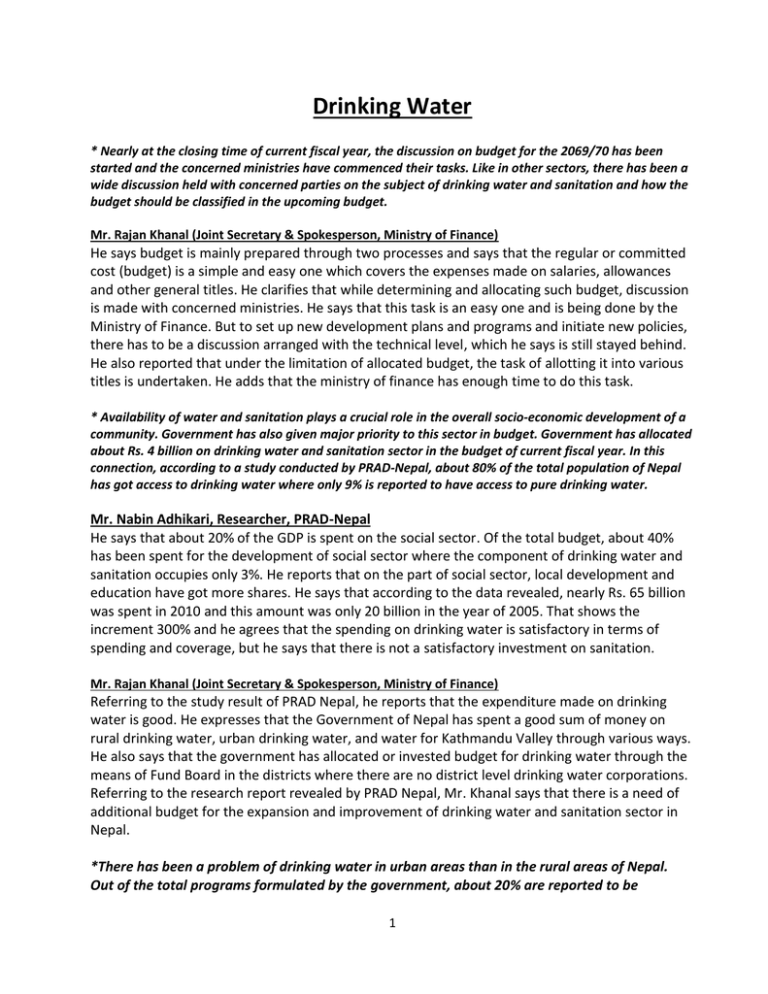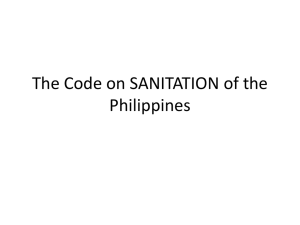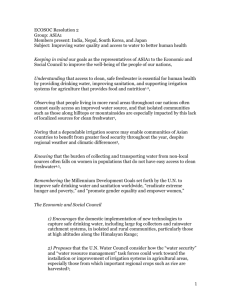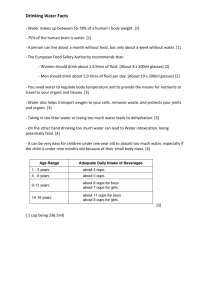Drinking Water
advertisement

Drinking Water * Nearly at the closing time of current fiscal year, the discussion on budget for the 2069/70 has been started and the concerned ministries have commenced their tasks. Like in other sectors, there has been a wide discussion held with concerned parties on the subject of drinking water and sanitation and how the budget should be classified in the upcoming budget. Mr. Rajan Khanal (Joint Secretary & Spokesperson, Ministry of Finance) He says budget is mainly prepared through two processes and says that the regular or committed cost (budget) is a simple and easy one which covers the expenses made on salaries, allowances and other general titles. He clarifies that while determining and allocating such budget, discussion is made with concerned ministries. He says that this task is an easy one and is being done by the Ministry of Finance. But to set up new development plans and programs and initiate new policies, there has to be a discussion arranged with the technical level, which he says is still stayed behind. He also reported that under the limitation of allocated budget, the task of allotting it into various titles is undertaken. He adds that the ministry of finance has enough time to do this task. * Availability of water and sanitation plays a crucial role in the overall socio-economic development of a community. Government has also given major priority to this sector in budget. Government has allocated about Rs. 4 billion on drinking water and sanitation sector in the budget of current fiscal year. In this connection, according to a study conducted by PRAD-Nepal, about 80% of the total population of Nepal has got access to drinking water where only 9% is reported to have access to pure drinking water. Mr. Nabin Adhikari, Researcher, PRAD-Nepal He says that about 20% of the GDP is spent on the social sector. Of the total budget, about 40% has been spent for the development of social sector where the component of drinking water and sanitation occupies only 3%. He reports that on the part of social sector, local development and education have got more shares. He says that according to the data revealed, nearly Rs. 65 billion was spent in 2010 and this amount was only 20 billion in the year of 2005. That shows the increment 300% and he agrees that the spending on drinking water is satisfactory in terms of spending and coverage, but he says that there is not a satisfactory investment on sanitation. Mr. Rajan Khanal (Joint Secretary & Spokesperson, Ministry of Finance) Referring to the study result of PRAD Nepal, he reports that the expenditure made on drinking water is good. He expresses that the Government of Nepal has spent a good sum of money on rural drinking water, urban drinking water, and water for Kathmandu Valley through various ways. He also says that the government has allocated or invested budget for drinking water through the means of Fund Board in the districts where there are no district level drinking water corporations. Referring to the research report revealed by PRAD Nepal, Mr. Khanal says that there is a need of additional budget for the expansion and improvement of drinking water and sanitation sector in Nepal. *There has been a problem of drinking water in urban areas than in the rural areas of Nepal. Out of the total programs formulated by the government, about 20% are reported to be 1 unimplemented. On one side, the government has targeted to provide drinking water to all by the end of 2015, but on the other a big problem is observed in the part of pure drinking water. Drinking water and sanitation are both included into one in the policy, but in the sector of sanitation there is less work done compared to the drinking water. Also, because of less communication and poor coordination among the authorities involved in the sector of drinking water and sanitation, essential progress is not obtained, and the problem of urbanization is viewed as an another obscurity to be so. Mr. Nabin Adhikari, Researcher, PRAD-Nepal Based on the results obtained from survey of PRAD-Nepal, he says that out of the total, 20% viewed that the Government budget on drinking water and sanitation was not functional at all, 20% reported that it was bad, 20% said that it was functional, and 55% were in the view that it was moderate. He explains that due to this there is no link up in productivity. He says that although sanitation and drinking water sectors are integrated together in policy, the coverage of sanitation is less while compared to the exposure of drinking water. Mr. Rajan Khanal (Joint Secretary & Spokesperson, Ministry of Finance) He says that the there are problems in distributing drinking water in urban areas because of the process of rapidly growing urbanization and lack of the sources of drinking water. Therefore to curtail this problem, he argues that alternative sources of water must be used to fulfill the demand of water either by harvesting rainwater or drawing it out from underground and purifying it. He also adds that the Municipality Development Fund has also been conducting some kinds of programs for distributing drinking water in the urban areas. *Concerned authorities have demanded additional funds to be allocated on the sector of drinking water and sanitation in the upcoming budget. Also, the focus should be spotlighted on the plans and actions formulated by the government, and careful attention should be given to the projects where there is public involvement and people are capable of conducting such projects in a sustainable way. Mr. Nabin Adhikari, Researcher, PRAD-Nepal He argues that there should be the reallocation and reshuffling of budget and tells that the non functional and partially functional drinking water projects must be made fully functional to achieve success. He views that in the new upcoming projects there must be an equal priority given to the sanitation and drinking water projects. He means that the budget allocated towards the sanitation sector must be like the one that is prepared for the drinking water projects. *At present, drinking water and sanitation has become a major problem in the valley and different parts of the country. Expansion on urbanization is a cause for this problem. To recuperate this problem, government has to allocate necessary budget on drinking water and sanitation and make the policies and rules effectively implementable. From this, it is expected that there will be some relief to the mass consumers. 2 Education *Government of Nepal has given much precedence for the development of education, and has listed this sector on the top priority at the list of Millennium Development Goal. In current fiscal year, the Government of Nepal has allocated about 17% of its total budget on Education sector spotlighting the need of education in the country. Likewise, local governments, communities, NGOs and INGOs have also significantly contributed to this sector. In regard to this connection, (Policy Research and Development) PRAD- Nepal has conducted a study focusing on the status, expenditure structure and the benefits obtained by the public from the Education Program Budget. Mr. Kishor Maharjan, Researcher, PRAD-Nepal He says that about 16-17% of the total budget is allocated by the Government of Nepal on education sector. He says that this expenditure is in rising ratio and this increment has become 14%. He reports that from the GDP, about 3.5% has been allocated on Education sector. According to him, in comparison to SAARC countries except India, Nepal has shown a significant rank regarding its investment on the education while it is almost equal when judged against India. Mr. Rajan Khanal, Joint Secretary & Spokesperson, Ministry of Financ He says that Education sector has got a significant importance and has been listed in the priority list of Millennium Development Goal. Referring to the report of Mid-Term Evaluation report, he says that the focus has to be set on the female children’s education, admission rate of students and increment of literacy rate in public schools. He expresses that out of the total, Rs. 62 billion is allocated for the education sector where almost 60 billion is only expended on salaries, allowance and facilities. *Results show that the expenditure on education is satisfactory. Currently, basic education, primary education and higher education projects are run through various planning and programs. Of the total education budget, statistics show that 60% has been invested on primary education only. Mr. Rajan Khanal, Joint Secretary & Spokesperson, Ministry of Finance He also states that the expenses on education is not satisfactory, and addresses that there is a need to increase the budget on education in the upcoming fiscal years. He recorded that there is 60% expenditure on primary education where 16% is allotted to basic education. He also focuses that at least 20% of the total government budget has to be allocated to education sector to meet the target of Millennium Development Goal. His view is that compared to other sectors, the progress in education has been acceptable and reports that there has been several awareness programs being held to do much better in this sector from educational and political branches. Mr. Kishor Maharjan, Researcher, PRAD-Nepal He says that about more than 60% of the total budget has been recorded to be invested on primary education and states that the Government is also focusing on this sector for several reasons. During last seven years, through about 43/44 to 50 programs, this amount of expenditure has been invested on education. The pattern of expenditure shows that 71 to 77% of the total expenditure source is obtained from the Government and 22 to 31% of expenditure is managed from external sources. *The subsidy and concession provided by the Government to the marginalized class of rural areas has not been reached. Although the access of such group is high on primary education, their access to secondary and higher education is much less. Also, it is essential to stabilize the investment of donors in this sector. 3 Mr. Rajan Khanal, Joint Secretary & Spokesperson, Ministry of Finance He says that if the allocated budget on education is invested accurately, there is question of depriving children from education in Nepal. He claims that there is no scarce of budget on education in fact, if invested correctly. Mr. Kishor Maharjan, Researcher, PRAD-Nepal He says that about 6% children of Nepal have not access to the primary education, and adds that the allocation has to be increased for the progress in basic education by providing educational special packages. He also raises the issue of cash transfer. He argues that if this cash transfer is implemented, excluded children or the children who are deprived of education can be included. He reports that although the access of poor households is alright towards primary education their access to higher and vocational education seems less. On the other side, the access of the children from rich households has been drastically reduced at primary, secondary and tertiary level, which he thinks might be due to the growing tendency of sending children to private schools among well to do families. *Although the investment on education sector has been increasing in public schools, the quality of education in latest years is diminishing. Even though they are expensive, compared to public schools, private schools are good in providing quality education and the trend of sending children to private schools is increasing. Mr. Kishor Maharjan, Researcher, PRAD-Nepal He clarifies that there are two types of education system in Nepal, private and public. Referring to the results obtained from the research, he says that the percentage of students who pass SLC exam from private schools is about 96-97 percentage. *For the overall socio-economic development of the country, the development of education is a fundamental base. To achieve this goal the government has to increase the budget on education. Also, the government has to identify the predicament rendering in this sector and must focus on minimizing such problems. 4 Health *Nearly at the closing time of current fiscal year, the discussion regarding budget for the upcoming year has been started. In this connection, PRAD Nepal in coordination with the Global Development Network has conducted a study on health, education and drinking water, the social sectors prioritized by the Government of Nepal with a goal of discovering the condition of budget planning, resources allocation and expenditure management. The aim of this study is to make the government conscious about the allocation of the budget and let them address this conclusion through budget. Mr. Prithvi Raj Ligal, Ex Vice-Chairman, National Planning Commission He states that the purpose of this study was to analyze the impact of the expenditure of program budget on health, education and drinking water and examine the effectiveness and implication of that budget on people since 2005 to 2011/12. He further says that the Benefit Incidence Analysis was conducted to see how the benefits were divided among all, whether the benefit was tilted on the side of rich or the poor. He added that over the program budget, the cost effective and policy simulation analysis were also conducted to examine the nature of the impact and result that could be seen when made some modifications on the program budget. He also says that this was examined from the perspective of cost analysis over the selection of programs. Based on the results obtained from the study and respondents’ benefits and feedbacks, he clarified that the aim of this study is to provide suggestions to the government for better and effective selection of programs and allocation of budgets in the days to come. *In the country, about 7% of the total budget is allocated to the health sector and this share becomes only 1.5% in total GDP. In latest years, the percentage of expenditures allocated to health sector has been increasing and due to this, country has been progressing in the areas of primary and basic health. Prof. Dr. Devendra Prasad Shrestha, Researcher, PRAD Nepal He reports that on the basis of the analysis of expenditure over the last five years, the allocation and spending on health sector is increasing. He adds that when analyzing the government expenditure on health, along with the increment of total budget in recent years, health sector has also got the significant amount of money to spend. Dr. Mingmar Gyaljen Sherpa, Director General, Health Service Department He says that compared to last year’s expenses the health budget is increasing. He adds that to meet the target of New Millennium Development Goal, Government has been making solid efforts from its side whatever it can and clarifies that it is close to the goal as well. The Ministry of Health has been implementing many programs and they are being successful. Rajan Khanal, Joint Secretary & Spokesperson, Ministry of Finance He states that the government has allocated huge amount of budget on the control of communicable diseases which is invested through the District Health Offices. He says that there 5 has been also a significant amount of expenditure on the supply of basic medicine to the public. He reports that the expenses are also made on the construction of rural health posts and launching of women-children welfare programs. *Yet, there have been many problems prevailing in the health sector in our country. The major problem is that the allocation of budget to this sector is being less than needed. Due to higher regular expenditure and lesser capital expenditure, the allocated budget has not been utilized properly. There is a high dependency upon the donors. Prof. Dr. Devendra Prasad Shrestha, Researcher, PRAD Nepal He says that the donor dependency is more on budget and reports that about 40% of the heath budget is still obtained from the external development sources. Dr. Mingmar Gyaljen Sherpa, Mahanirdehak, Health Service Department He says that the vision for health must be prepared by the Government and this must be made on the bases of needs, no matter how long or short period it takes to accomplish the target, but should not be a low grade vision. *The Government has invested for the development of heath sector but it has not been able to take proper care on its infrastructural improvement. As a result of this, the access to private health services is increasing as stated by the experts involved in this sector. Prof. Dr. Devendra Prasad Shrestha, Researcher, PRAD Nepal He argues that if about 10% of the total budget is allocated to health sector, the problem of resource crisis could be addressed. He also states that to understand the standard percentage of budget that is to be allocated to the health sector from total budget in any country can be observed from the WHO’s Macro Economic Modeling Study Policy. He agrees that there is a growing trend of taking health services from the private sector by the public compared to the services provided by the Government. Dr. Mingmar Gyaljen Sherpa, Director General, Health Service Department He says that the people have the concept of thinking that public hospitals do not provide good services to public. Furthermore, he adds that there is a lot improvement in public health services compared to the health services provided by public health institutions 10 years ago. He views that the government has responsibility of providing good health services to the public all over the country whereas the private hospitals may think of only few hospitals so that they can provide better health services compared to the Government health service providers. *Although the investment on health sector in recent years has been increasing significantly, the per capita health expenditure of the country is still less. Therefore, it is necessary to increase budget in this sector. Also, it is necessary for the government to consider the conclusions that are revealed from the studies and researches related to health sector and address them in the budget. 6







